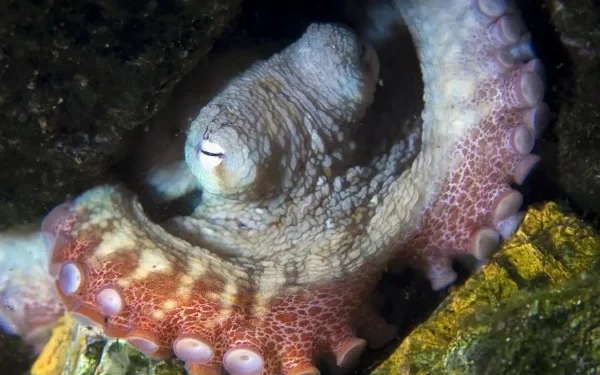Among the many marvels of marine biology, the octopus stands out as one of the most intelligent and biologically unique creatures in the animal kingdom. One of its most astonishing features is that it has three hearts — a rare and remarkable trait that plays a crucial role in its survival under the ocean’s pressures and depths.
This complex circulatory system is not just a biological quirk — it is an evolutionary adaptation that allows the octopus to thrive in low-oxygen environments and manage its active, predatory lifestyle beneath the sea.
Why Does an Octopus Have Three Hearts?
Unlike most animals that function with a single heart, the octopus circulatory system is specifically adapted for life in deep, cold waters. These three hearts work in a synchronized manner, each with its own vital task, to ensure the efficient circulation of oxygenated blood throughout its body.
Here is a breakdown of how each heart works:
1. Systemic Heart: The Main Circulatory Pump
The systemic heart is responsible for pumping oxygen-rich blood from the gills to the rest of the octopus’s body. This heart operates much like the single heart in mammals, propelling oxygenated blood through a complex network of vessels to nourish tissues and organs.
However, there is a twist — when the octopus swims, this systemic heart temporarily stops beating. This physiological limitation is one of the reasons the octopus prefers to crawl rather than swim. Swimming becomes a strenuous activity that reduces circulation efficiency, making crawling a more energy-conserving mode of movement.
2. Two Branchial Hearts: Dedicated to Oxygen Extraction
The octopus has two branchial hearts, also known as gill hearts, that are located near the gills. These two hearts function independently, each pumping deoxygenated blood from the body to one of the two gills. At the gills, oxygen is absorbed, and the blood becomes oxygenated, ready to be sent to the systemic heart.
Essentially, while the systemic heart handles distribution, the branchial hearts handle oxygen intake. This three-heart system ensures that the octopus can efficiently process the limited oxygen available in deep-sea environments.
The Science Behind Blue Blood: Hemocyanin vs. Hemoglobin
Another intriguing feature of the octopus’s biology is the color of its blood. Unlike humans and most vertebrates whose blood is red due to hemoglobin, an octopus has blue blood.
This coloration comes from hemocyanin, a copper-based molecule used for oxygen transport. Hemocyanin is more efficient than hemoglobin at transporting oxygen in cold, low-oxygen environments — precisely the conditions where many octopuses live.
Key Differences Between Hemocyanin and Hemoglobin:
| Feature | Hemoglobin (Humans) | Hemocyanin (Octopus) |
|---|---|---|
| Oxygen Carrier | Iron-based | Copper-based |
| Blood Color | Red | Blue |
| Efficiency | Optimal in warm, oxygen-rich environments | Optimal in cold, oxygen-poor environments |
This unique adaptation makes the octopus especially suited to deep-sea living, where oxygen levels can be dangerously low for other animals.
Adaptations of the Octopus to Deep-Sea Life
Having three hearts and blue blood are just part of the octopus’s extraordinary survival toolkit. The octopus has developed numerous biological adaptations that allow it to thrive in the ocean, including:
Camouflage and Skin Color Change
Octopuses are famous for their ability to change color and texture almost instantly. Specialized skin cells called chromatophores allow them to blend seamlessly with their surroundings. This not only helps them avoid predators but also aids in hunting.
Intelligence and Problem-Solving
Octopuses are considered among the most intelligent invertebrates. They have complex nervous systems, with over 500 million neurons, most of which are located in their arms. This makes them capable of learning, solving puzzles, escaping enclosures, and even using tools.
Jet Propulsion Movement
Though they prefer crawling, octopuses can also use jet propulsion to swim rapidly by expelling water through a specialized siphon. However, as noted earlier, this motion is metabolically expensive due to the temporary halt of the systemic heart.
Evolutionary Significance of a Three-Heart Circulatory System
The development of a three-heart system in the octopus is a prime example of evolutionary specialization. As marine invertebrates without backbones, octopuses face specific physiological challenges:
- No internal skeleton for support
- Thin body wall and flexible shape
- High mobility and predatory behavior
- Variable oxygen availability in their environment
To meet these challenges, octopuses evolved a dual-function circulatory system — two hearts to ensure gills get enough blood for oxygenation and a central heart to distribute that oxygen efficiently throughout the body. This adaptation gives them the endurance needed for active hunting and camouflage-based survival.
Species and Habitat Diversity in Octopuses
There are over 300 species of octopuses, found in oceans all over the world — from shallow reefs to deep-sea trenches. Some notable species include:
- Common Octopus (Octopus vulgaris): Found in tropical and temperate waters worldwide.
- Giant Pacific Octopus: Known for its massive size and deep-water habitat.
- Blue-Ringed Octopus: Small but highly venomous, found in the Pacific and Indian Oceans.
Each species has adapted uniquely to its environment, but the presence of three hearts and blue blood remains consistent across the octopus family.
Interesting Facts About Octopuses
Here are some more fascinating tidbits about these incredible creatures:
- They have nine brains: One central brain and a small cluster of neurons in each of their eight arms.
- Octopuses can regrow lost arms, making them incredibly resilient.
- They have no bones, allowing them to squeeze through incredibly small spaces.
- They are masters of escape, often breaking out of aquariums or sealed containers in labs.
The Importance of Studying Octopuses in Marine Biology
Understanding the unique biology of the octopus provides insights into evolutionary biology, neurology, and even robotics. Their decentralized nervous system has inspired research into autonomous systems and flexible robotic limbs.
Moreover, studying how octopuses manage oxygen transport with three hearts and blue blood helps researchers understand adaptive mechanisms that could one day influence medical or environmental technologies.
Conclusion: A Living Marvel of the Deep Sea
The octopus is truly one of nature’s most fascinating creatures. From its three-heart circulatory system to its blue copper-based blood, everything about the octopus is a testament to the power of evolution and adaptation. These features allow it to survive and thrive in some of the most challenging environments on Earth.
For anyone interested in marine biology, physiology, or even science fiction-like wonders of the natural world, the octopus offers an endless source of fascination — proving that sometimes, the most alien creatures aren’t from outer space, but from the depths of our own oceans.

























